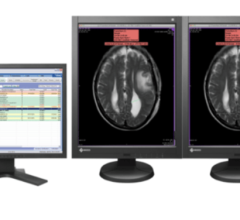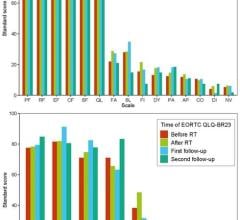Researchers from Banner Alzheimer's Institute (BAI) have developed a new brain image analysis method to better track the progression of beta-amyloid plaque deposition, a characteristic brain abnormality in Alzheimer's disease, according to a study published in the March issue of the Journal of Nuclear Medicine. Investigators also believe this new approach may make it easier to evaluate investigational anti-amyloid treatments in clinical trials.
During the last decade, researchers have been using positron emission topography (PET) to assess amyloid plaque deposition in patients with clinical symptoms of Alzheimer's and in cognitively normal persons at risk for the disease. They also have been using it to assess the ability of investigational treatments to slow the further accumulation of amyloid or remove plaques that already exist.
Amyloid plaques are typically measured by comparing measurements from the cerebral cortex, where plaques accumulate most, to a reference region that is relatively spared, like the cerebellum. Unfortunately, when plaques are measured this way, there can be substantial variability from one scan to the next, due at least in part to technical reasons.
BAI investigators have shown that the use of another reference region--cerebral white matter--can greatly reduce this variability. These findings are consistent with results reported in the same journal issue by Landau, et al., who similarly concluded that cerebral white matter permits better tracking of amyloid deposition. Findings from both studies support the use of a white matter reference region to improve the power to track progressive amyloid changes and evaluate amyloid-modifying treatments using amyloid PET.
"We and other researchers have been interested in finding better ways to track the brain changes associated with Alzheimer's disease and evaluate investigational treatments in the most rapid and cost-effective way," said Eric Reiman, M.D., the study's senior researcher and executive director of the Banner Alzheimer's Institute. "We hope that this new image analysis technique will help in that endeavor."
Kewei Chen, Ph.D., the study's lead researcher, and his team analyzed baseline and 24-month follow-up florbetapir (a compound that binds to beta-amyloids) PET scans in 332 participants of the Alzheimer's Disease Neuroimaging Initiative (ADNI), a public-private partnership working to advance Alzheimer's research. Of the 332 participants, 31 had clinical diagnoses of probable Alzheimer's dementia, 187 had diagnoses of mild cognitive impairment and 114 were cognitively normal older adults.
The team compared the uptake of the amyloid PET ligand florbetapir in the cerebral cortex to its uptake in three different reference regions--cerebral white matter, pons and cerebellum. This calculation, known as a standard-uptake-value ratio (SUVR), allowed investigators to determine which of the reference regions provided the best tracking of amyloids over the course of two years.
Chen and colleagues found that using the cerebral white matter reference region resulted in more accurate tracking of SUVRs among patients with probable Alzheimer's, patients with mild cognitive impairment, and those older adults who, although cognitively normal, were found to be amyloid positive at their baseline visit. The cerebral-to-cerebral white matter SUVR increases also correlated with poorer scores on study participants' neurocognitive tests, whereas SUVRs from the other reference regions failed to demonstrate this pattern.
Compared to the pontine and cerebellar reference regions, the cerebral white matter reference region also resulted in less variability in repeated florbetapir SUVRs readings (e.g., less paradoxical decreases) over time in patients with probable Alzheimer's.
"The white matter reference region not only improved the ability to track SUVR increases, it permitted us to find close associations between SUVR increases and clinical declines in the overall subject group," said Chen. "While additional studies are needed to demonstrate the generalizability of this approach to other amyloid PET ligands, we are excited about its potential to help in the scientific study of Alzheimer's disease and the evaluation of amyloid-modifying treatments."
For more information: banneralz.org


 April 23, 2024
April 23, 2024 








